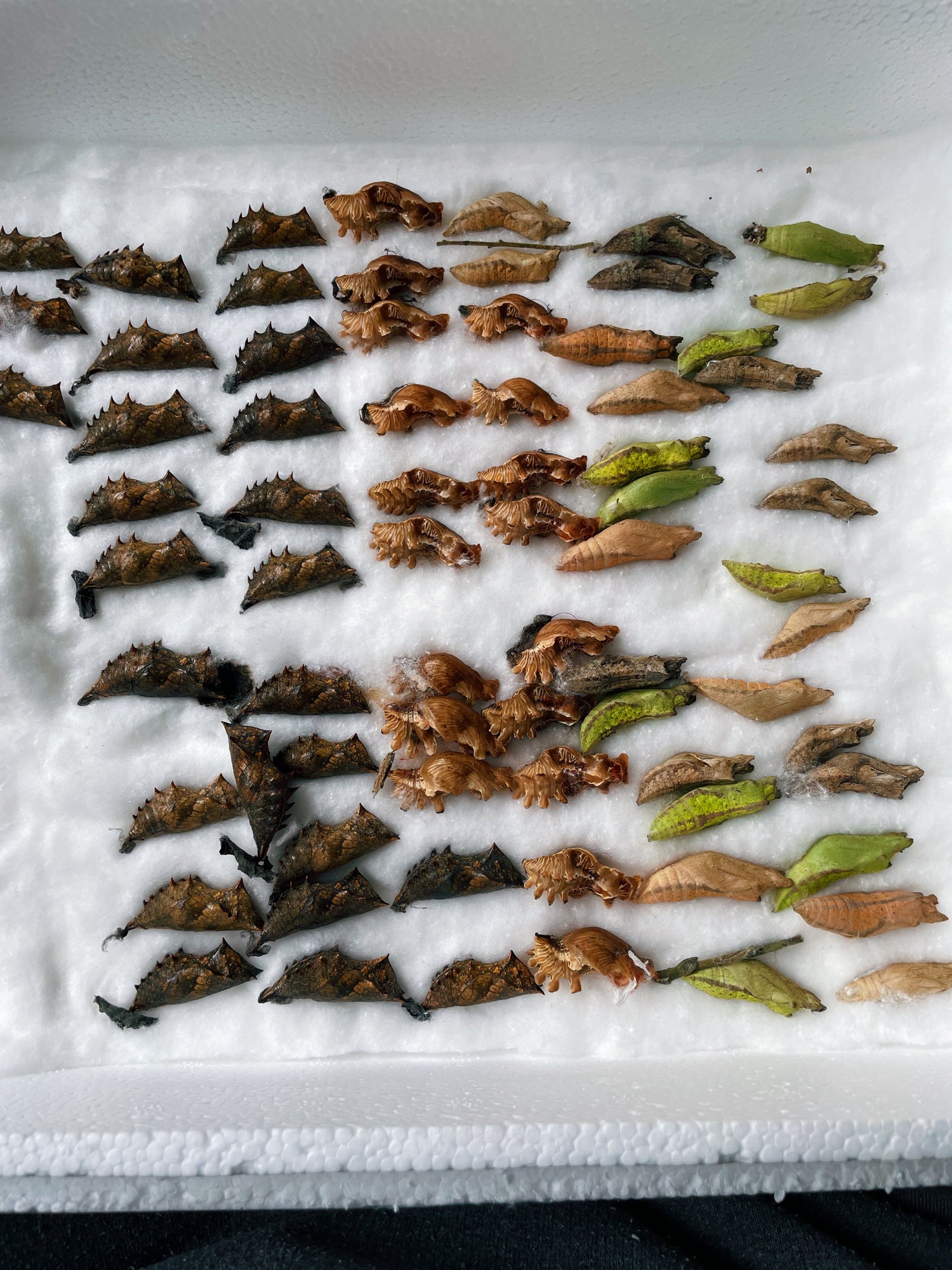Butterfly & Moth Pupae & Cocoon Care Guide
When your caterpillars have finished feeding and are ready to pupate, they enter a sensitive, immobile stage — whether as a bare chrysalis or a protective cocoon. Proper care of pupae and cocoons is crucial for successful emergence of healthy butterflies or moths. This guide covers all key aspects of pupae care: from unpacking / housing, to humidity and temperature, to emergence and overwintering.
It’s written with both UK native species and exotic butterflies / moths in mind, making it useful for enthusiasts, schools and breeders alike. Follow the advice below to maximise survival and give emerging adults the best start.


Understanding Pupae & Cocoons – What Needs They Have
- Pupae (chrysalises) and cocoons are immobile and fragile — they cannot move to regulate moisture or temperature.
- They are highly prone to desiccation (drying out), especially small species — once a pupa loses too much water, it may fail to emerge or result in malformed wings.
- They also need stable environmental conditions (humidity, temperature, light, minimal disturbance) until emergence — any sudden change or shock can be fatal.
Because of these constraints, a well-prepared pupation / emergence setup is essential.

Blue Morpho pupa
Morpho helenor pupa with silk pad attached - if present, use silk pads to pin and suspend the pupa
What To Do After Receiving Pupae / Cocoons
If you ordered pupae or cocoons, unpack carefully and remove all packing materials (cotton wool, paper, etc.). Cotton wool left on can cause moisture-related issues. It is a good idea to lay them on a damp cloth or tissue paper for 10 minutes to rehydrate after travelling. You do not need to do this if you reared them yourself.
A perfect emergence enclosure can be created using a polystyrene box. This is easy and cheap: a decent sized polystyrene box relative to the number of pupae you are hatching should be easy to buy online. Tropical butterflies and moths enjoy warmth and humidity. That said, most pupae emerge best at room temperature or slightly warmer during the day, e.g. 20-24 degrees, with a drop of a few degrees at night.
Some people opt to use glass enclosures for pupae and cocoons, however we find boxes to be far easier to clean and can easily be moved or stored. A heat mat is often a welcome addition for tropical species, e.g. on the side or base of your emergence enslosure, but never use heat lamps/lights on eggs, caterpillars or cocoons/pupae - this will dehydrate and dessicate them, killing the pupae quickly. Heat should be moderate and accompanied by high humidity (80%+). Room temperature is fine for most silkmoths, hawkmoths, and native or temperate species. Avoid direct sunlight as this can also overheat the pupae - in nature, pupae are typically formed in shady, humid undergrowth.
Native/temperate butterflies are more robust and can typically be kept in a mesh cage without any intervention, although a very fine spray every day or two will benefit the developing butterfly (mimicking the natural hydration gained from rain or dew).

Euploea core pupae
The beautiful metallic pupae of the Common Crow butterfly look like drops of silver and gold!
Care
You can suspend your butterfly pupae using pins or glue. Wherever possible, use pins to suspend pupae by their silk pad; if they do not have this intact, a glue gun or superglue can be used to secure pupae to a pin or bamboo cane.
Most of the silk-moths and hawk-moths are more hardy than small butterfly pupae, so for these simply lay the pupae or cocoons out on the base of their enclosure and spray with water once a day - these can be kept in mesh cages as long as humidity is maintained.
Some species need to go through a period of dormancy before emerging to breed. This is the case for Robin moths and Emperor moths, as they only fly once per year. To break their dormancy, known as diapause, these require cold storage. Then incubate for emergence after at least 2-3 months of dormancy.
Heliconius charithonia pupae
Note that these Zebra Longwing pupae are suspended by pins through the small silk pad at the top of the pupa.
When & How to Prepare for Emergence
- For most butterfly species, pupae will emerge in about 1–2 weeks if kept at appropriate room temperature; for moths, this is much more variable and depends on the species. Lower temps can delay emergence; higher temps may speed it up (but risk dehydration).
- When setting up the enclosure for emergence: check that the it has enough vertical space for the adult to hang and fully expand its wings.
- Do not disturb or shake the emergence container — delicate pupae and newly-emerged butterflies and moths can be harmed by sudden movement.
- Provide perches or mesh so emerging adults can hang and expand their wings.
.
Overwintering & Delayed Emergence (If Applicable)
Some species naturally enter diapause (a state of dormancy) if pupation occurs late in the season when days are shortening or under cooler conditions.
If you anticipate delayed emergence or plan to hold pupae over winter:
- Keep pupae in a cool, frost-free place (e.g. a fridge, unheated shed or outbuilding) — but avoid freezing.
- Maintain slight humidity — occasionally mist or keep a damp substrate nearby, but do not soak or spray pupae directly
- Check periodically for moisture, mould or desiccation.

Tropical butterfly pupae
A selection of pupae that had just arrived from our butterfly farm suppliers abroad.